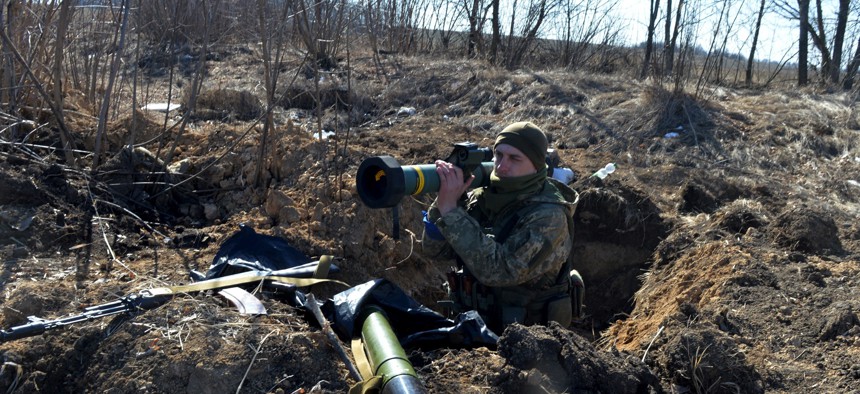
A Ukrainian soldier holds a FGM-148 Javelin, an American-made anti-tank missile, at a checkpoint near Kharkiv on March 23, 2022. SERGEY BOBOK/AFP via Getty Images
US Mulls Larger Permanent Force in Europe, Sends More Missiles to Ukraine
U.S., NATO will take "hard look" at European security footprint no matter how the Ukrainian fight goes, U.S. official says.
The latest U.S. planeloads of anti-aircraft and anti-tank weapons for Ukraine are expected to arrive in Europe this week, then be rushed into the country via ground routes, a senior defense official told reporters Wednesday.
The Stinger and Javelin missiles aboard those planes are part of the $800 million in additional security assistance President Joe Biden announced for Ukraine last week.
The weapons delivery is part of the ongoing international response to Russia’s invasion of Ukraine, which could require more U.S. troops to head overseas now, but ultimately also produce a larger and permanent U.S. and NATO footprint.
Biden, Defense Secretary Lloyd Austin, and Secretary of State Anthony Blinken landed in Brussels on Wednesday for an emergency NATO summit and European Council meeting.
“The security environment in Europe is different now,” the defense official said. “And it will be different no matter what the outcome is of this war. I think it's safe to say that the United States, as well as other NATO nations, will be taking a hard look at whether we have the footprint right and whether the posture is appropriate to the new security environment that results from all this. …We're going to be open to discussing with our allies what the new security environment is going to require of every NATO ally, including us.”
As part of its immediate response to Russia’s actions, the U.S. has deployed more than 14,000 troops to NATO’s eastern front. Sending in even more short-term forces is a possibility, the senior defense official said.
On Wednesday, NATO Secretary General Jens Stoltenberg announced the alliance would deploy four more battle groups to bolster defenses for Bulgaria, Hungary, Romania, and Slovakia.
“In terms of the immediate need to bolster the Eastern flank with temporary forces, the secretary is obviously looking at this every day and monitoring it,” the U.S. defense official said. “We're not going to take off the table the possibility that he will flow more forces in from the United States or reposition them from elsewhere in Europe.”
Now, as Russia’s invasion of Ukraine has reached its 28th day, Ukrainian forces have repelled some attacks by ground troops around the country and some Russian forward elements have stopped their advances short of reaching Kyiv. But some of those stalled Russian units are also now establishing defensive positions.
Russia continues to fire long-range missiles at Ukrainian targets; the Pentagon’s estimate has climbed past 1,200.
Also Wednesday, Stoltenberg said NATO will send protective gear to Ukraine to use in the event of chemical or biological weapons attacks. The U.S. defense official said its aid does not include that gear, because it was not seen as an immediate priority.
The U.S. shipments will include “small arms, ammunition, Stingers, Javelins, body armor, and helmets,” for the vast number of Ukrainian civilian men and women who have remained in the country to fight.
Jacqueline Feldscher contributed to this report.




